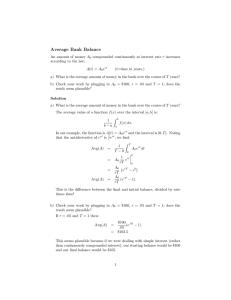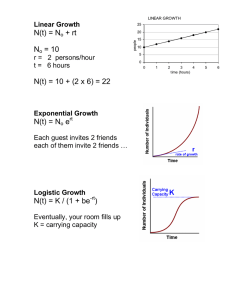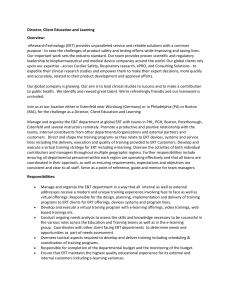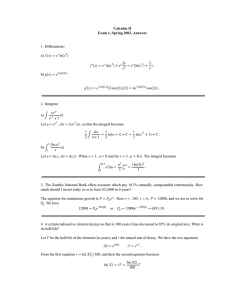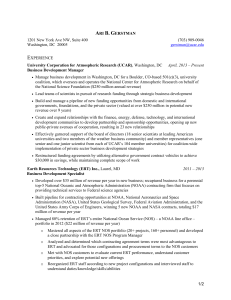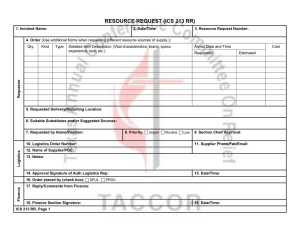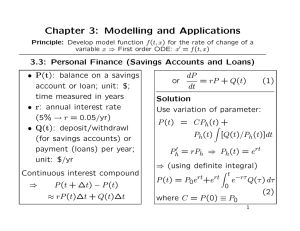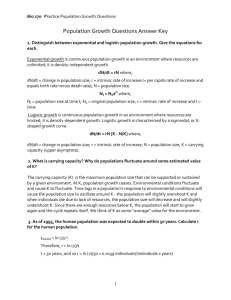CHAPTER 1 INTRODUCTION 1.1
advertisement
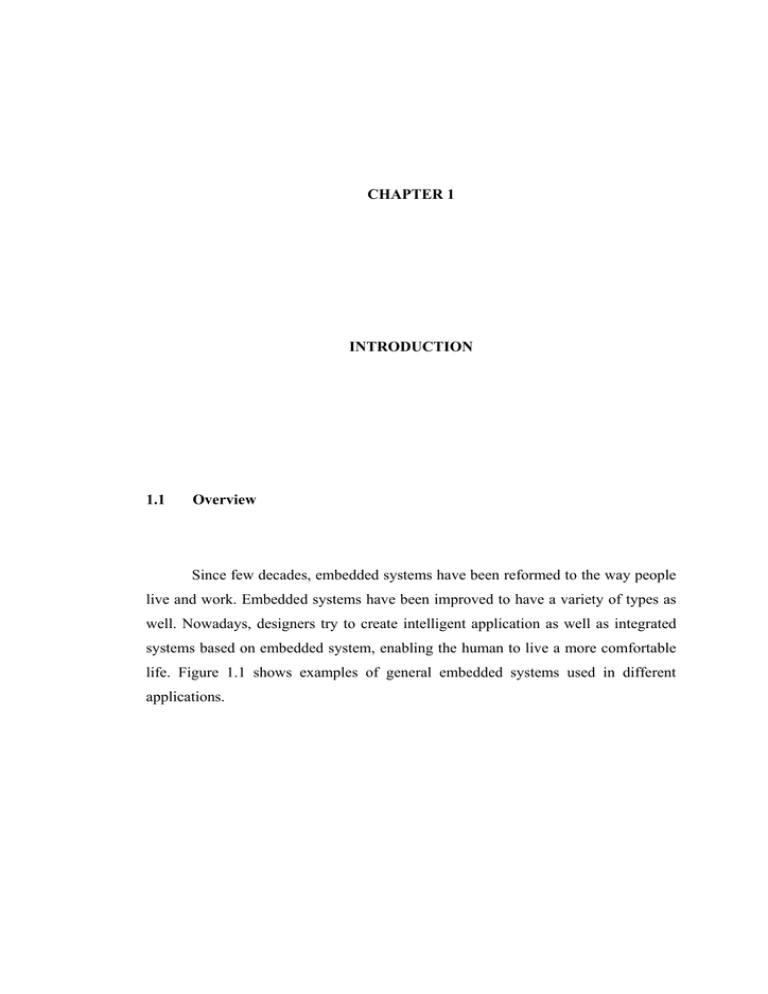
1 CHAPTER 1 INTRODUCTION 1.1 Overview Since few decades, embedded systems have been reformed to the way people live and work. Embedded systems have been improved to have a variety of types as well. Nowadays, designers try to create intelligent application as well as integrated systems based on embedded system, enabling the human to live a more comfortable life. Figure 1.1 shows examples of general embedded systems used in different applications. 2 Figure 1.1: Example of embedded systems A Real Time System (RTS) is intended to achieve the functionality under timing constraint. Real time systems are used in wide variety of applications, such as avionics, automotive, patient monitoring and etc. A missing deadline is anonymous to disastrous consequences such as loss of life in patient monitoring. So RTS must be reliable and operate with functional and non functional requirements. Requirements needed to respond on external events in real time are identified as a special class of embedded systems. Figure 1.2 shows the relation of RTS and embedded systems (Qing Li, 2000). The integration of the two systems called Embedded Real Time system (ERT). 3 Figure 1.2: Embedded real time system The vast majority of embedded real time systems have been managed by software. However software managing in the ERT domain is difficult and complex. For example some systems are complex like: there are more or less than 1400 interconnected software with controlled functions distributed on 80 embedded computers in some parts of car industry. So ERT software must consider high quality attributes such as safety, reliability, resource efficiency, and timing. Vehicular industry needs to improve software engineering approaches that will increase development efficiency, support handling the complexity, facilities’ safety, reliability and timing assessment (Akerholm, 2008). Abilities of ERT systems modeling are improved by expressing the real time features such as time quality service and resources constraint. So, designers can verify and validate the features easily. In addition, designers are able to manage the complexity of real time system by high quality modeling. The quality of real time technology is improved if the software development goal can be achieved at the minimum time by using standard modeling and high performance of code generators. Designers can design and develop the software of ERT system iteratively. This process can be speed up by using the modeling and code generation tools, if processes of ERT software have high speed. Obviously, high speed code generators affect on number of the design and development process (Pilaud, 1997). 4 In addition number of code errors is decreased by using the extensive automatic code generation. For the Airbus A340, automatically generated code accounted for 70% of the total (pilaud, 1998). Moreover, total control over the software life cycle can be achieved when the specification changes during the development stage. That can be traced of monitor clearly by using the modeling and code generation tools under perfect control. Those involved pointed out the ability to very quickly and reliability deploys the modified software after a request for change. 1.2 Problem Background The design and implementation of ERT systems should consider multiple constrains that do not comply with large component and object cased systems like business data processing system. These constrains include (Crnkovic, 2005; Goos, 2005): i. Real time systems should cover constraints of extra-functional properties such as timing quality of service and dependability (including reliability, safety, and security). This means the system should satisfy explicit response time constraints, otherwise, it will fail. ii. The system is safety-critical in which the functional and extra functional properties are to be statically predictable. iii. Real time systems must often be operated with resources constraint. 5 The developed framework consists of three main elements: a modified component model, a component based timing analysis approach, and a code generator.ERT frameworks can be represented by ERT tools. Modular Approach to Software framework Operation and Test (MASCOT) is one of the oldest ERT frameworks which consider the concurrency processes such as a number of defense systems. MASCOT is applied on Rapier ground to air missile system of the British Army. In the meantime, MASCOT is appropriate for concurrency processing but there is no standard modeling for it. That’s why MASCOT is not applicable in modern ERT, because the requirements specification and software design phases are based on the traditional software lifecycle (Budgen, 1994). Furthermore, the cost of design modification was too high. Complexity of the ERT is increased in a large scale requirement with the limitation of resources, so risks of ERT systems will be increased. Moreover, modern embedded systems must support rapid convergence of a multiple of disparate technologies. There have been many efforts to import oriented design methodologies and framework such as ROOM, OCTOPUS and COMET for the sake of ERT complexity removal. Furthermore, there has been a growth of commercial modeling tools to support these methodologies such as IBM Rational RoseRT, ARTiSAN Real Time Studio, I-Logix Rhapsody, Telelogic Tau and IAR visual STATE. Such tools are not only used for creating models and running simulations but also for the automatic generation of executable code. They help developers for achieving the requirements widely on code generators. Real time performance will be increased by object oriented method; however the discrepancies between objects and tasks make it difficult to handle. So, many developers are forced to find their task sets through trial and error. 6 However a large number of ERT modern frameworks are based on component software system (CBSE) such as OMG’s CORBA Component Model (CCM), Microsoft’s COM, COM++, Rational Rose RT, and Simulink. Advantages code generation in CBSE are: i. Higher quality software and shorter ones together with more predictable delivery cycles. Executing models is the suitable way to find problems. ii. Creating appropriate platform to handle the code generators on large scale. iii. Possibility of code generation modification (reverse engineering) to affect the modeling part. A formal notation of component interface which is enabled by component base framework such as COP provides a way to describe the interaction between components, and to verify the compatibility between components automatically. The physical processes to be controlled are continuous but the algorithms are implementing using discrete software components. Although each individual model is relatively clear, but it is difficult and complex to implement the integration of heterogeneous models based on low cost design (Chen, 2004). Another important issue of component base framework is code generator which is achieved based on formal notation of component.COP code generator provides target the codes in C language for optimal code generation with resource constrained micro controller. 7 1.3 Problem Statement There are many ERT code generator component technologies as mentioned before, but the existing frameworks don’t possess all of the important features of Component Base Development (CBD) based ERT code generator. The aim of this research is to identify the important criteria of the code generator framework component based in ERT systems, and then these criteria will be evaluated and compared with available CBD frameworks. Next this study will select the best framework based on these criteria to ensure the framework capability to support code generation in CBD. And then, the selected framework will be further evaluated and validated based on an ERT case study. The main research questions are: How can we evaluate and validate the code generation of ERT software base on CBD approach? What are the problems of the existing code generators? i. What are the criteria to review ERT code generators based on CBD approach? ii. Which code generator is the best according to ERT code generator criteria set? iii. Is it possible to match the selected code generator and Component Oriented Programming (COP) framework? iv. How to develop the tools to support COP? 8 1.4 Project Aim The aim of this research is: Evaluate the exiting ERT code generators framework in CBD approach and develop tool to support some features from the exiting code generator. 1.5 i. Objective of the Study To identify important code generation criteria of ERT for CBD approach and, evaluate the ERT framework based on selected criteria. ii. To implement a case study with the selected code generator framework. iii. To develop the COP environment tool to support the selected criteria. iv. To compare the COP tool with the selected code generator tool in supporting some of criteria. 1.6 i. Scope of the Project Focusing on the architecture of code generation details of five commercial and research ERT systems. ii. Identify the features of code generation for component base development (CBD) on embedded real time system (ERD). iii. Choosing an ERT system framework, and execute it based on the case study. iv. Develop code generation tool based on the COP framework.

